This image shows the Heliophysics System Observatory (HSO). The HSO
utilizes the entire fleet of solar, heliospheric, geospace, and
planetary spacecraft as a distributed observatory to discover the larger
scale and/or coupled processes at work throughout the complex system
that makes up our space environment. The HSO consist of 18 operating
missions: Voyager, Geotail, Wind, SOHO, ACE, Cluster, TIMED, RHESSI,
TWINS, Hinode, STEREO, THEMIS, AIM, CINDI, IBEX, SDO, ARTEMIS, Van Allen
Probes
WASHINGTON
-- NASA's next scientific satellite, which is scheduled for launch June
26, will provide the most detailed look ever at the sun's lower
atmosphere or interface region.
The Interface Region Imaging Spectrograph (IRIS) mission will observe how solar material moves, gathers energy, and heats up as it travels through this largely unexplored region of the solar atmosphere. The interface region, located between the sun's visible surface and upper atmosphere, is where most of the sun's ultraviolet emission is generated. These emissions impact the near-Earth space environment and Earth's climate.
The IRIS spacecraft was designed and built by Lockheed Martin's Advanced Technology Center in Palo Alto, Calif. It will launch aboard an Orbital Sciences Corp. Pegasus XL rocket deployed by the company's L-1011 aircraft from Vandenberg Air Force Base on the central California coast.
"IRIS data will fill a crucial gap in our understanding of the solar interface region upon joining our fleet of heliophysics spacecraft," said Jeffrey Newmark, NASA's IRIS program scientist in Washington. "For the first time we will have the necessary observations for understanding how energy is delivered to the million-degree outer solar corona and how the base of the solar wind is driven."
IRIS carries an ultraviolet telescope that feeds a multi-channel imaging spectrograph. The satellite is the first mission designed to use an ultraviolet telescope to obtain high-resolution images and spectra every few seconds and provide observations of areas as small as 150 miles across the sun.
"Previous observations suggest there are structures in this region of the solar atmosphere 100 to 150 miles wide, but 100,000 miles long," said Alan Title, IRIS principal investigator at Lockheed Martin. "Imagine giant jets like huge fountains that have a footprint the size of Los Angeles and are long enough and fast enough to circle Earth in 20 seconds. IRIS will provide our first high-resolution views of these structures along with information about their velocity, temperature and density."
After launch, IRIS will travel in a polar, sun-synchronous orbit around Earth, crossing nearly directly over the poles in such a way that it moves over the equator at the same local time each day. The spacecraft will orbit at an altitude range of 390 miles to 420 miles. This orbit allows for almost continuous solar observations on IRIS' two-year mission.
NASA's Ames Research Center in Moffett Field, Calif., will provide IRIS mission operations and ground data systems. The Norwegian Space Centre in Oslo, Norway, will provide regular downlinks of science data. NASA's Launch Services Program at the agency's Kennedy Space Center is responsible for launch management.
IRIS is a NASA Small Explorer Mission, which the agency's Goddard Space Flight Center in Greenbelt, Md., manages for the Science Mission Directorate in Washington. The goal of the Explorers Program is to provide frequent flight opportunities for world-class scientific investigations from space utilizing innovative, streamlined and efficient management approaches within the heliophysics and astrophysics science areas.
Other IRIS contributors include the Smithsonian Astrophysical Observatory in Cambridge, Mass.; Montana State University in Bozeman, Mont.; Stanford University in Stanford, Calif.; and the University of Oslo in Norway.
For graphics related from the June 4 IRIS news conference, visit:
For more information about the IRIS mission, visit:
| Next Animation Number |
|
IRIS L-14 Media Briefing |
|||||||||||||||||
|
Lying just above the sun's surface is an enigmatic region of the
solar atmosphere called the interface region. A relatively thin region,
just 3,000 to 6,000 miles thick, it pulses with movement: zones of
different temperature and density are scattered throughout, while energy
and heat course through the solar material. Understanding how the energy travels through this region – energy that helps heat the upper layer of the atmosphere, the corona, to temperatures of 1,000,000 kelvins, some thousand times hotter than the sun's surface itself – is the goal of NASA's Interface Region Imaging Spectrograph, or IRIS, scheduled to launch on June 26, 2013 from California's Vandenberg Air Force Base. Scientists wish to understand the interface region in exquisite detail, since energy flowing through this region has an effect on so many aspects of near-Earth space. For one thing, despite the intense amount of energy deposited into the interface region, only a fraction leaksthrough, but this fraction drives the solar wind, the constant stream of particles that flows out to fill the entire solar system. The interface region is also the source of most of the sun's ultraviolet emission, which impacts both the near-Earth space environment and Earth's climate. IRIS's capabilities are uniquely tailored to unravel the interface region by providing both high-resolution images and a kind of data known as spectra, which can see many wavelengths at once. For its high-resolution images, IRIS will capture data on about one percent of the sun at a time. While these are relatively small snapshots, IRIS will be able to see very fine features, as small as 150 miles across. |
|||||||||||||||||
|
|
|||||||||||||||||
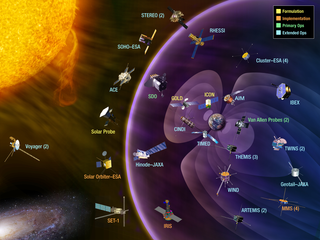
|
This image shows the Heliophysics System Observatory (HSO). The
HSO utilizes the entire fleet of solar, heliospheric, geospace, and
planetary spacecraft as a distributed observatory to discover the larger
scale and/or coupled processes at work throughout the complex system
that makes up our space environment. The HSO consist of 18 operating
missions: Voyager, Geotail, Wind, SOHO, ACE, Cluster, TIMED, RHESSI,
TWINS, Hinode, STEREO, THEMIS, AIM, CINDI, IBEX, SDO, ARTEMIS, Van Allen
ProbesCredit: NASA Available formats: 1500 x 1125 JPEG 931 KB |
||||||||||||||||
|
|
|||||||||||||||||
|
|
|||||||||||||||||
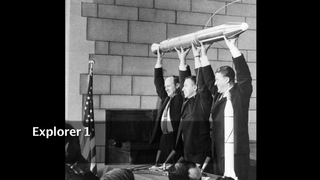
|
This movie shows images and data from the NASA Explorers Program
since the first one Explorer 1 in 1958, through the nobel prize winning
COBE, to the newest one to be launched, IRIS. The Explorers Program is
the oldest continuous program in NASA . Explorers are one of three
flight programs within the Heliophysics portfolio and provide frequent
spaceflight opportunities for world-class science investigations for a
relatively modest cost. Credit: NASA
Duration: 50.3 seconds Available formats: 1280x720 (59.94 fps) QT 886 MB 1280x720 (59.94 fps) QT 106 MB 1280x720 (29.97 fps) QT 18 MB 640x360 (29.97 fps) QT 16 MB 1280x720 (29.97 fps) MPEG-4 13 MB How to play our movies |
||||||||||||||||
|
|
|||||||||||||||||
|
|
|||||||||||||||||
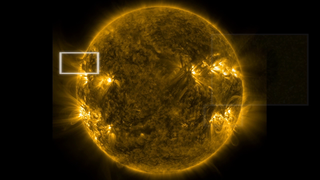
|
IRIS will advance our understanding of how the enigmatic interface
region on the sun powers its dynamic million-degree atmosphere called
the corona. IRIS will join the Solar Dynamics Observatory (SDO) which
launched in 2010 and NASA/JAXA Hinode (launched in 2006). Together they
will explore how the solar atmosphere works and impacts Earth – SDO and
Hinode monitoring the solar surface and outer atmosphere, with IRIS
watching the region in between. This movie shows a full disk movie of
the corona as seen by SDO with movies of the surface of the Sun, called
the photosphere, and the chromosphere as seen by Hinode.Credit: NASA SDO; NASA/JAXA Hinode; GSFC
Duration: 30.1 seconds Available formats: 1280x720 (59.94 fps) QT 521 MB 1280x720 (59.94 fps) QT 138 MB 1280x720 (29.97 fps) QT 19 MB 1280x720 (29.97 fps) MPEG-4 5 MB 640x360 (29.97 fps) QT 23 MB How to play our movies |
||||||||||||||||
|
|
|||||||||||||||||
|
|
|||||||||||||||||
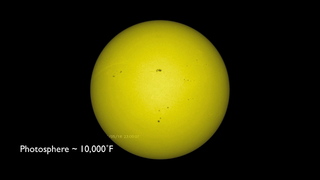
|
A sequence of images from the surface to the Corona taken by the
Heliospheric and Magnetic Imager (HMI) and Atmospheric Imaging Assembly
(AIA) instruments on the Solar Dynamics Observatory (SDO).Credit: NASA SDO
Duration: 37.5 seconds Available formats: 1280x720 (59.94 fps) QT 606 MB 1280x720 (29.97 fps) QT 8 MB 1280x720 (59.94 fps) QT 40 MB 1280x720 (29.97 fps) MPEG-4 5 MB 640x360 (29.97 fps) QT 7 MB How to play our movies |
||||||||||||||||
|
|
|||||||||||||||||
|
|
|||||||||||||||||
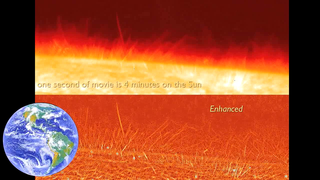
|
Jets at the limb seen in the light of Calcium II by the Focal Plane Package on the JAXA/ISAS Hinode Mission.Credit: JAXA/ISAS Hinode
Duration: 16.7 seconds Available formats: 1280x720 (59.94 fps) QT 287 MB 1280x720 (59.94 fps) QT 116 MB 1280x720 (29.97 fps) QT 39 MB 1280x720 (29.97 fps) MPEG-4 15 MB 640x360 (29.97 fps) QT 30 MB How to play our movies |
||||||||||||||||
|
|
|||||||||||||||||
|
|
|||||||||||||||||
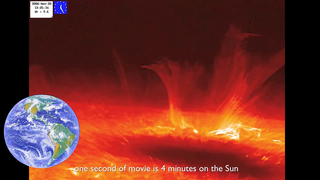
|
Jet and plumes near a sunspot near the limb seen in the light of
Calcium II by the Focal Plane Package on the JAXA/ISAS Hinode Mission.Credit: JAXA/ISAS, Hinode
Duration: 20.9 seconds Available formats: 1280x720 (59.94 fps) QT 355 MB 1280x720 (59.94 fps) QT 73 MB 1280x720 (29.97 fps) QT 13 MB 1280x720 (29.97 fps) MPEG-4 5 MB 640x360 (29.97 fps) QT 19 MB How to play our movies |
||||||||||||||||
|
|
|||||||||||||||||
|
|
|||||||||||||||||
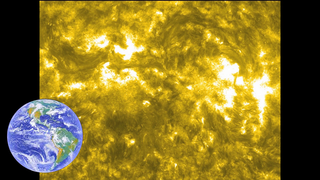
|
Blinks between and image in He II and an enhanced image. The
original image is from AIA on SDO and the enhanced image was created at
the LM Solar and Astrophysics Laboratory (LMSAL).Credit: Dr. Alan Title, LMSAL
Duration: 18.8 seconds Available formats: 1280x720 (59.94 fps) QT 318 MB 1280x720 (59.94 fps) QT 69 MB 1280x720 (29.97 fps) QT 21 MB 1280x720 (29.97 fps) MPEG-4 11 MB 640x360 (29.97 fps) QT 13 MB How to play our movies |
||||||||||||||||
|
|
|||||||||||||||||
|
|
|||||||||||||||||
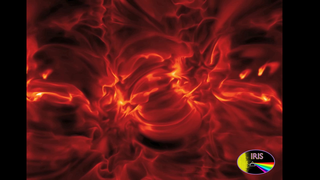
|
A simulation of the Sun in UV light. The movie pans from disk center to the limb. Credit: Prof. Mats Carlsson at Oslo University
Duration: 15.4 seconds Available formats: 1280x720 (59.94 fps) QT 262 MB 1280x720 (59.94 fps) QT 70 MB 1280x720 (29.97 fps) QT 16 MB 1280x720 (29.97 fps) MPEG-4 7 MB 640x360 (29.97 fps) QT 21 MB How to play our movies |
||||||||||||||||
|
|
|||||||||||||||||
|
|
|||||||||||||||||
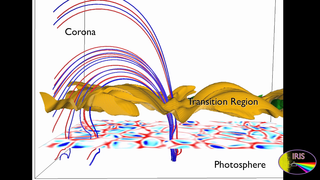
|
A simulation of heating by a jet. Credit: Dr. Juan Sykora at LMSAL
Duration: 8.6 seconds Available formats: 1280x720 (59.94 fps) QT 151 MB 1280x720 (59.94 fps) QT 18 MB 1280x720 (29.97 fps) QT 5 MB 1280x720 (29.97 fps) MPEG-4 4 MB 640x360 (29.97 fps) QT 4 MB How to play our movies |
||||||||||||||||
|
|
|||||||||||||||||
|
|
|||||||||||||||||
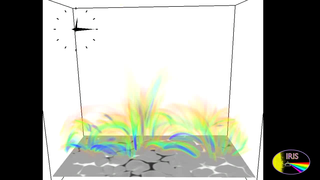
|
A simulation of the location of heating in the transition region. Credit: Prof. Viggo Hansteen University of Oslo
Duration: 21.6 seconds Available formats: 1280x720 (59.94 fps) QT 286 MB 1280x720 (59.94 fps) QT 21 MB 1280x720 (29.97 fps) QT 3 MB 1280x720 (29.97 fps) MPEG-4 2 MB 640x360 (29.97 fps) QT 5 MB How to play our movies |
||||||||||||||||
|
|
|||||||||||||||||
|
|
|||||||||||||||||
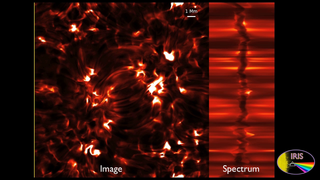
|
A simulation of the Sun and corresponding spectra in Mg II. Credit: Prof. Mats Carlsson, University of Oslo
Duration: 21.7 seconds Available formats: 1280x720 (59.94 fps) QT 379 MB 1280x720 (59.94 fps) QT 21 MB 1280x720 (29.97 fps) QT 5 MB 1280x720 (29.97 fps) MPEG-4 4 MB 640x360 (29.97 fps) QT 6 MB How to play our movies |
||||||||||||||||
|
|
|||||||||||||||||
|
|
|||||||||||||||||
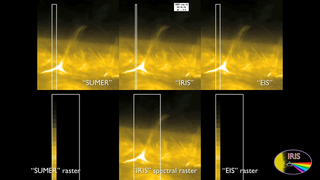
|
A comparison of IRIS image reconstruction with previous instruments. Credit: Dr. Bart de Pontieu at LMSAL
Duration: 56.8 seconds Available formats: 1280x720 (59.94 fps) QT 999 MB 1280x720 (59.94 fps) QT 83 MB 1280x720 (29.97 fps) QT 9 MB 1280x720 (29.97 fps) MPEG-4 9 MB 640x360 (29.97 fps) QT 17 MB How to play our movies |
||||||||||||||||
|
|
|||||||||||||||||
|
|
|||||||||||||||||

|
This graphic shows the IRIS observatory with the solar arrays
removed. The orange section to the left is the spacecraft bus which
includes the spacecraft support structure, the command and data handling
system, power distribution system, reaction wheels, X- and S-Band
communications systems, Li-Ion battery, magnetic torque rods, and
electronics for the sun sensors. The section to the right of the
spacecraft includes the instrument optics package and electronics,
several components of the attitude control system, and the solar arrays.
The instrument includes a 20cm telescope optimized for solar
observations which feeds a 5 channel imaging spectrograph. The green
section is the telescope assembly, the light blue section is the
spectrograph, and the dark blue box is the separate instrument
electronics box.
Credit: LMSAL, LM ATC
Available formats: 1280 x 720 JPEG 147 KB |
||||||||||||||||
|
|
|||||||||||||||||
|
|
|||||||||||||||||
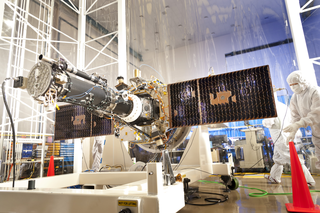
|
This is a photo of the complete IRIS observatory with the solar
arrays deployed. This is taken in a large clean tent at LM prior to
vibration testing and prior to installation of the flight MLI blankets.
The solar arrays have just been deployed using flight commands.
Credit: LM photo
Available formats: 4256 x 2832 JPEG 2 MB |
||||||||||||||||
|
|
|||||||||||||||||
|
|
|||||||||||||||||
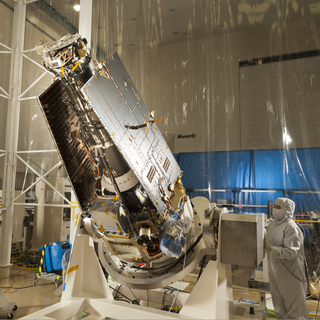
|
A second picture of the IRIS observatory. The solar arrays have
been stowed in preparation for vibration and shock testing.
Credit: LM Photo
Available formats: 2825 x 2825 JPEG 1 MB |
||||||||||||||||
|
|
|||||||||||||||||
|
|
|||||||||||||||||
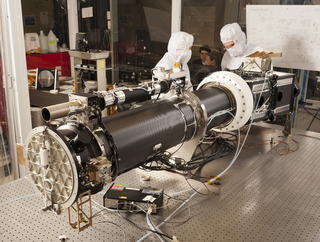
|
Photo of the instrument optics package prior to instrument level
thermal vacuum testing. The section to the left of the white collar is
the 20cm solar telescope and the section to the right of the collar is
the imaging spectrograph. The spectrograph includes 18 optics used for
transmitting the light from the telescope through the 4 channels to the
focal planes as shown in the next sequence of images. On top of the
telescope assembly is the smaller guide telescope which provides the
pointing signal to the secondary mirror of the telescope and to the
attitude control system in the spacecraft. The white collar is the
primary mirror radiator used to reject the solar thermal load.Credit: LM Photo
Available formats: 3705 x 2798 JPEG 2 MB |
||||||||||||||||
|
|
|||||||||||||||||
|
|
|||||||||||||||||
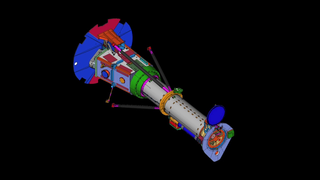
|
The optical portion of the instrument and the light paths from
the primary and secondary mirror of the telescope assembly into the
spectrograph. The spectrograph then breaks the light into 2 Near Ultra
Violet (NUV)(2785A – 2835A) and 2 Far Ultra-violet (FUV) (1332A-1406A)
and one imaging channel.Credit: LMSAL
Duration: 27.2 seconds Available formats: 1280x720 (59.94 fps) QT 278 MB 1280x720 (59.94 fps) QT 7 MB 1280x720 (29.97 fps) QT 1 MB 1280x720 (29.97 fps) MPEG-4 2 MB 640x360 (29.97 fps) QT 1 MB How to play our movies |
||||||||||||||||
|
|
|||||||||||||||||
|
|
|||||||||||||||||
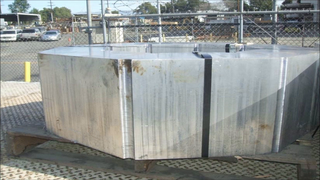
|
These series of photos show the fabrication of the bus structure
from a large block of aluminum to the completed bus assembly. Credit: LM Video
Duration: 24.0 seconds Available formats: 1280x720 (59.94 fps) QT 407 MB 1280x720 (59.94 fps) QT 110 MB 1280x720 (29.97 fps) QT 2 MB 1280x720 (29.97 fps) MPEG-4 2 MB 640x360 (29.97 fps) QT 2 MB How to play our movies |
||||||||||||||||
|
|
|||||||||||||||||
|
|
|||||||||||||||||
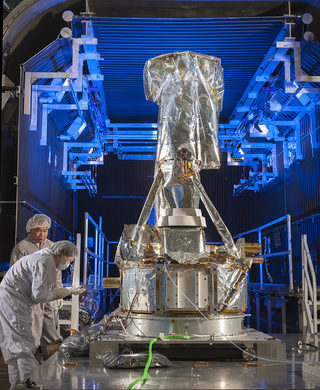
|
IRIS observatory (without solar arrays) after completion of
thermal vacuum and thermal balance testing. Engineers are inspecting
the observatory and preparing for transport back to the clean tent for
solar array install and final performance testing. A protective cover
is on top of the telescope assembly. The vacuum chamber is in the
background. Thermal vacuum testing was the last in a series of
environmental tests including: vibration testing, pyro-shock
(separation) testing, EMI/EMC testing, and thermal vacuum and thermal
balance. Optical and system performance tests are carried out
throughout the test program to ensure that the observatory meets all of
its requirements.Credit: PM Photo
Available formats: 821 x 1000 JPEG 540 KB |
||||||||||||||||
|
|
|||||||||||||||||
|
|
|||||||||||||||||
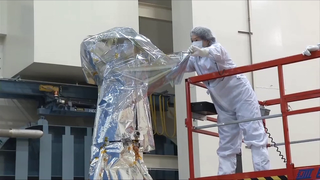
|
This video shows the transportation of the IRIS observatory from
the thermal vacuum chamber back to the clean tent for final testing and
preparations for delivery to the launch site at Vandenberg Air Force
Base. The second part of the vide shows the final solar array
deployment test. The arrays were released using flight commands. This
shows the observatory in its final flight configuration including the
MLI blankets. This is how the observatory will appear in orbit with the
front of the telescope facing the sun.Credit: LM Video
Duration: 59.0 seconds Available formats: 1280x720 (59.94 fps) QT 1014 MB 1280x720 (59.94 fps) QT 336 MB 1280x720 (29.97 fps) QT 54 MB 1280x720 (29.97 fps) MPEG-4 20 MB 640x360 (29.97 fps) QT 68 MB How to play our movies |
||||||||||||||||
|
|
|||||||||||||||||
|
|
|||||||||||||||||
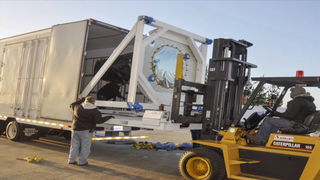
|
These series of photos show the receipt of the observatory at the
Orbital processing facility at VAFB. The observatory was received on
April 16, 2013 and transferred to its handling fixture and then
transferred to a clean tent located at the third stage of the Pegasus
rocket. Several photos show the processing of the observatory in the
clean tent including the installation of the separation system that
mates the observatory to the rocket. The final photos show the Pegasus
rocket and the fairings being prepared for installation.Credit: NASA/Kennedy Space Flight Center
Duration: 1.0 minutes Available formats: 1280x720 (59.94 fps) QT 1 GB 1280x720 (59.94 fps) QT 488 MB 1280x720 (29.97 fps) QT 25 MB 1280x720 (29.97 fps) MPEG-4 15 MB 640x360 (29.97 fps) QT 64 MB How to play our movies |
||||||||||||||||
|
|
|||||||||||||||||
|
|
|||||||||||||||||
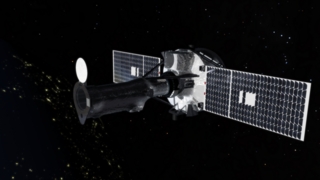
|
A video showing the deployment of the Pegasus Rocket with the observatory from the Orbital L1011.The rocket is dropped from the L1011 and is in unpowered, guided flight for 5 sec The first stage lights and burns for 72 sec, then coasts for 17 sec. The rocket is at 71km prior to lighting of the second stage. The second stage lights and burns for 73 sec, then coasts for 37 sec. The fairing separates at 131 sec. The rocket is at 600km prior to the firing of the third stage Third stage burns for 69 sec placing the observatory in orbit at approximately 660km. Once the payload is at 660km, the third stage and payload separate, at 786 seconds and the third stage carries out maneuvers to clear the observatory orbit. The observatory then deploys the solar arrays, acquires the sun, and begins a 30 day on-orbit checkout and commissioning phase. After a 21 day outgassing and checkout period, the front door is opened and checkout of the optical systems started. Credit: NASA/Goddard Space Flight Center/Conceptural Image Lab Duration: 1.8 minutes Available formats: 1280x720 (59.94 fps) QT 1 GB 1280x720 (60 fps) Frames 1280x720 (59.94 fps) QT 568 MB 1280x720 (30 fps) QT 54 MB 1280x720 (29.97 fps) QT 24 MB 1280x720 (29.97 fps) MPEG-4 19 MB 1280x720 TIFF 2 MB How to play our movies |
||||||||||||||||
|
|
|||||||||||||||||
|
|
|||||||||||||||||

|
This video clip shows a few team members at the IRIS Mission
Operations Center (MOC) preparing for a day of activities. The IRIS
MOC, part of the NASA Ames Multi-Mission Operations Center (MMOC),
serves as an example of a small, low cost operations shared facility for
NASA.Credit: NASA/Ames Research Center
Duration: 6.4 seconds Available formats: 1280x720 (59.94 fps) QT 107 MB 1280x720 (59.94 fps) QT 37 MB 1280x720 (29.97 fps) QT 4 MB 1280x720 (29.97 fps) MPEG-4 1 MB 640x360 (29.97 fps) QT 9 MB How to play our movies |
||||||||||||||||
|
|
|||||||||||||||||
|
|
|||||||||||||||||
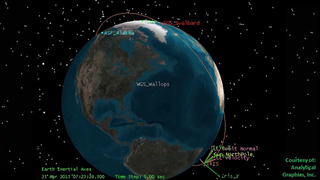
|
This animation shows the IRIS 620kmx670km, approximate 98 degree
inclination, sun-synchronous, polar orbit. Each 97 minute revolution
results in 14-15 orbits per day on average and allows for long stretches
of uninterrupted or eclipse free solar viewing.Credit: Analytical Graphics, Inc., STK/Lockheed-Martin/IRIS
Duration: 18.0 seconds Available formats: 1280x720 (59.94 fps) QT 310 MB 1280x720 (59.94 fps) QT 37 MB 1280x720 (29.97 fps) QT 5 MB 1280x720 (29.97 fps) MPEG-4 4 MB 640x360 (29.97 fps) QT 8 MB How to play our movies |
||||||||||||||||
|
|
|||||||||||||||||
|
|
|||||||||||||||||
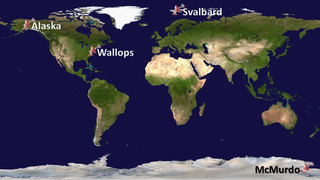
|
This animation shows the initial orbit ground track of the IRIS
observatory once it is launched off the western coast of the United
States. Communications with the TDRSS allow immediate communications
with the Observatory. Within 15-20 minutes, IRIS passes over the
McMurdo Ground Station in Antarctica. Approximately one hour after
launch IRIS passes over the north pole, Svalbard Ground Station, then
shortly afterward communicates with the Alaska Satellite Facility. On
the fifth orbit Wallops Ground Station comes into view.Credit: NASA/IRIS
Duration: 28.6 seconds Available formats: 1280x720 (59.94 fps) QT 500 MB 1280x720 (29.97 fps) QT 4 MB 1280x720 (59.94 fps) QT 23 MB 1280x720 (29.97 fps) MPEG-4 5 MB 640x360 (29.97 fps) QT 4 MB How to play our movies |
||||||||||||||||
|
|
|||||||||||||||||
|
|
|||||||||||||||||

|
This animation shows the ground stations and primary facilities
used to support the IRIS mission. IRIS collaborates with the Norwegian
Space Centre as they provide a science data path for the mission. The
NEN or Near Earth Network located at Goddard Space Flight Center
provides the central hub for ground station support. Data makes its way
to the Mission Operations Center at NASA Ames as science data and
images are eventually stored at Stanford. The solar data is then used
in multiple ways to benefit society and space exploration.Credit: NASA/IRIS
Duration: 41.0 seconds Available formats: 1280x720 (59.94 fps) QT 702 MB 640x360 (29.97 fps) QT 7 MB 1280x720 (59.94 fps) QT 37 MB 1280x720 (29.97 fps) MPEG-4 6 MB 1280x720 (29.97 fps) QT 8 MB How to play our movies |
||||||||||||||||
|
|
|||||||||||||||||
|
|
|||||||||||||||||
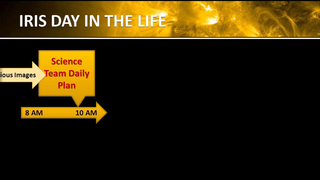
|
This animation provides a look at the tasks the team on the ground
perform daily as they prepare for and upload a command set once per
weekday. During nominal operations, science and observatory health data
are captured daily in a “lights-out” mode. Within six hours, science
data is processed and stored at the Science Data Processing facility at
Stanford University. A website provides a portal for the public science
community to access the data.Credit: NASA Ames Research Center/IRIS
Duration: 57.5 seconds Available formats: 1280x720 (59.94 fps) QT 953 MB 1280x720 (59.94 fps) QT 19 MB 1280x720 (29.97 fps) QT 5 MB 1280x720 (29.97 fps) MPEG-4 9 MB 640x360 (29.97 fps) QT 4 MB How to play our movies |
||||||||||||||||
|
|
|||||||||||||||||
|
|
|||||||||||||||||
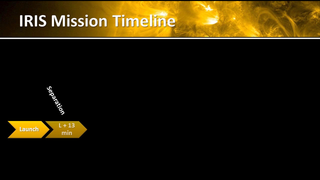
|
This animation shows the timeline of activities for the IRIS
mission. Following launch, during the initial orbits, the spacecraft
“detumbles”, opens the solar arrays, acquires the sun and communicates
with the TDRSS and ground stations. For the first thirty days, the
instrument and spacecraft are carefully checked and the telescope door
is opened on day 21. The science campaign officially begins on day 60
as IRIS begins its exploration of the sun. Nominal daily operations
continue for an exciting two year solar mission. After two years, if
the observatory is healthy and productive, NASA then has the option to
extend science operations.NASA Ames Research Center/IRIS
Duration: 27.5 seconds Available formats: 1280x720 (59.94 fps) QT 413 MB 1280x720 (59.94 fps) QT 5 MB 1280x720 (29.97 fps) QT 1 MB 1280x720 (29.97 fps) MPEG-4 3 MB 640x360 (29.97 fps) QT 976 KB How to play our movies |
||||||||||||||||
|
|
|||||||||||||||||
|
|
|||||||||||||||||
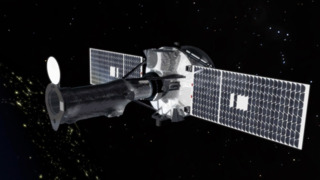
|
Video File for Newsrooms and EditorsCleanroom b-roll, launch, deploy, and beauty pass animations.
Duration: 5.2 minutes Available formats: 1280x720 JPEG 340 KB 1280x720 QT 4 GB How to play our movies |
||||||||||||||||
|
|
|||||||||||||||||
Share:
 E-mail E-mail
 Twitter Twitter
|
|||||||||||||||||
| Other multimedia items related to this story: | |||||||||||||||||
| IRIS Launch, Deploy and Beauty Passes (id 11089) | |||||||||||||||||
| IRIS: Studying the Energy Flow that Powers the Solar Atmosphere (id 11256) | |||||||||||||||||
| |||||||||||||||||
NASA
Guillermo Gonzalo Sánchez Achutegui
ayabaca@gmail.com
ayabaca@hotmail.com
ayabaca@yahoo.com

No hay comentarios:
Publicar un comentario